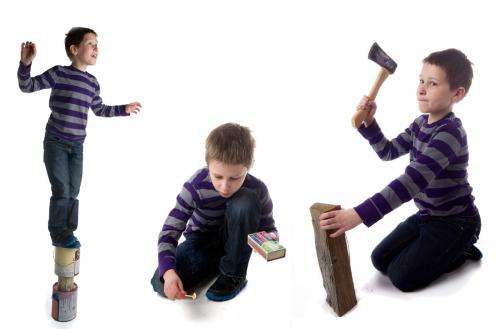Study examines how parents can teach their children to be safer

As parents, we've all been there: Watching our children teeter on a chair, leap from the sofa, or careen about the playground, fearing the worst. And, we all wonder, how can we teach them to be safer?
Such was the goal of a team of researchers at the University of Iowa, who analyzed in a new study how children take stock of various real-life scenarios, and how mothers can help them assess potential hazards. Their conclusions: Children and mothers regularly don't see eye-to-eye on situational dangers. Because of that, it's critical that mothers explain why a situation is dangerous, beyond simply administering a verbal slap on the wrist.
"One of the biggest worries for any parent is keeping their child safe from injury," explains Jodie Plumert, UI psychology professor and co-author on the study, published in the Journal of Pediatric Psychology. "It's pretty simple when the child is young, because parents directly supervise him (or her). But what about when the child gets older, becomes more independent and goes out on his own? That's when the responsibility for staying safe transfers from the parent to the child. And that means the child has to be able to assess the danger of situations. We think parent-child conversations are the bridge to doing that."
Of course, children can learn to be more careful by simply trying stuff. But Plumert's team wanted to know whether parents could pre-empt that, and, if so, how. To find out, the researchers showed 63 mothers and their 8- and 10-year-olds photos of other children engaged in various activities. Some – such as a photo of a child swinging a hand-held ax to chop wood or striking a match with a canister of lighter fluid nearby – screamed danger; others – such as riding a skateboard in the driveway or climbing on a countertop – appeared more benign. Separately, the mother and child rated the danger of each scenario on a four-point scale, from very safe to very unsafe. Children also were asked to rate how scared they'd be to perform the activity, also on a four-point scale.
The researchers then brought the mother and child together and asked them to agree on a "safety" rating for each scenario. In about a third of the cases, the mother and child rated the danger of the scenario differently, the researchers found. Despite the initial disagreement, the team also found that mothers were able to bring the child around to their way of thinking 80 percent of the time. In other words, the mother, in most cases, "encouraged their child to actively participate in independently thinking about the safety of the activities and also guided the child to their own way of thinking about the safety of the activities in cases of disagreement," the researchers write.
So, how did they do that? That's where talking became important, Plumert notes. But not just any kind of talk, she adds.
"Saying to your child, 'Don't do that' or 'Stop' or 'Be careful' doesn't really work," Plumert says. "I mean, it's okay to say that, but the next step is to say why not. You shouldn't assume that your child knows why not, even if it seems obvious to you."
Mothers used one tactic especially effectively: They pointed out the dangerous elements in the situation, and explained how those current dangers could cause the child to get hurt. The researchers were initially surprised that mothers focused more on the present features rather than pointing out potential outcomes, but think it's because parents use the present – the danger – to help the child understand the potential outcome – getting injured.
Still, there are some children who are prone to injury, no matter what. These are the risk-takers, and the researchers learned that these children are more likely to view a situation as less dangerous than their peers.
"It's like these kids discount the danger in the situations," says Elizabeth O'Neal, a third-year graduate student in psychology and corresponding author on the paper. "I think, for them, there's always this competition between being cautious and having fun."
These children likely need more parental explanation to counteract their hell-bent-for-leather inclinations, the researchers say.
"In terms of intervention, the mother-child conversation might be especially important for these risk-takers than with the cautious kids," Plumert notes.
O'Neal and Plumert are the paper's sole authors. There was no outside funding for the research.

















